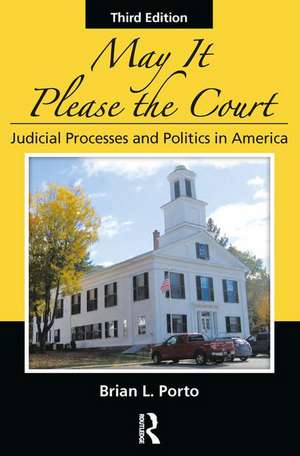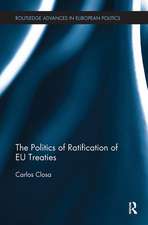May It Please the Court: Judicial Processes and Politics In America
Autor Brian L. Portoen Limba Engleză Hardback – 16 aug 2017
Unlike the many dull and inaccessible texts in this field, May It Please The Court conveys the human drama of civil and criminal litigation. With an updated epilogue, case studies, and discussion questions, this third edition is a robust resource for criminal justice students.
| Toate formatele și edițiile | Preț | Express |
|---|---|---|
| Paperback (1) | 640.74 lei 3-5 săpt. | +23.32 lei 7-11 zile |
| Taylor & Francis – 9 aug 2017 | 640.74 lei 3-5 săpt. | +23.32 lei 7-11 zile |
| Hardback (1) | 935.69 lei 6-8 săpt. | |
| Taylor & Francis – 16 aug 2017 | 935.69 lei 6-8 săpt. |
Preț: 935.69 lei
Preț vechi: 1256.17 lei
-26% Nou
Puncte Express: 1404
Preț estimativ în valută:
179.06€ • 194.44$ • 150.41£
179.06€ • 194.44$ • 150.41£
Carte tipărită la comandă
Livrare economică 22 aprilie-06 mai
Preluare comenzi: 021 569.72.76
Specificații
ISBN-13: 9781138043404
ISBN-10: 1138043400
Pagini: 388
Ilustrații: 7
Dimensiuni: 156 x 234 mm
Greutate: 0.7 kg
Ediția:3
Editura: Taylor & Francis
Colecția Routledge
Locul publicării:Oxford, United Kingdom
ISBN-10: 1138043400
Pagini: 388
Ilustrații: 7
Dimensiuni: 156 x 234 mm
Greutate: 0.7 kg
Ediția:3
Editura: Taylor & Francis
Colecția Routledge
Locul publicării:Oxford, United Kingdom
Cuprins
Illustrations
Preface
Acknowledgments
About the Author
1 Courts and Judges in the Political Process 1
1.1 Law and Politics: Myth and Reality 1
1.2 The Political Context of Judging
1.2.1 Courts in the American Political System
1.2.2 Links between Law and Politics
1.2.3 The Differences between Law and Politics
1.3 Reconciling Law and Politics
1.4 Conclusion: Law, Politics, and Judicial Decisions
1.5 Epilogue: The Law and Politics of Public
Protest
2 American Courts—Structures and Procedures
2.1 Federalism and the Judiciary
2.2 State Court Systems
2.2.1 Introduction
2.2.2 Trial Courts of Limited Jurisdiction
2.2.3 Trial Courts of General Jurisdiction
2.2.4 Intermediate Appellate Courts
2.2.5 Courts of Last Resort
2.3 The Federal Court System
2.3.1 Introduction
2.3.2 Specialized Federal Courts
2.3.3 U.S. District Courts
2.3.4 U.S. Courts of Appeals
2.3.5 The U.S. Supreme Court
2.4 Federal Court Administration
2.5 Relations between State and Federal Courts
2.6 Conclusion
2.7 Epilogue: The Roots of Judicial Federalism
3 Lawyers and Lawyering
3.1 Introduction
3.2 A Brief History of the Legal Profession
3.3 The Legal Profession Today
3.3.1 Entry
3.3.2 Culture
3.3.3 Practice
3.3.4 Challenges
3.4 Conclusion
3.5 Epilogue: Campaign Solicitations in Judicial
Elections
4 Judicial Selection and Removal
4.1 Law, Politics, and Judicial Nominations
4.2 Judicial Selection in the States
4.2.1 Introduction
4.2.2 Election
4.2.3 Appointment
4.2.4 Appointment-and-Election
4.2.5 Legislative Election
4.2.6 Conclusion
4.3 Discipline and Removal of State Judges
4.4 Selection of Federal Judges
4.4.1 Introduction
4.4.2 The Lower Federal Courts
4.4.3 The Supreme Court
4.5 Discipline and Removal of Federal Judges
4.6 Conclusion
4.7 Epilogue: Free Speech and Judicial Elections
5 Norm Enforcement—The Criminal Justice Process
5.1 Introduction
5.2 State v. Johnson: Facts
5.3 State v. Johnson: Participants
5.3.1 The Defendant
5.3.2 The Defense Attorney
5.3.3 The Prosecutor
5.3.4 The Judge
5.4 State v. Johnson: Process
5.4.1 Pretrial
5.4.1.1 Arraignment
5.4.1.2 Preliminary Hearing
5.4.1.3 Indictment
5.4.1.4 Plea Bargain
5.4.1.5 Motions
5.4.2 Trial
5.4.2.1 Defendant’s Right to a Speedy Trial
5.4.2.2 Jury Selection
5.4.2.3 Opening Statements
5.4.2.4 Presentation of Evidence
5.4.2.5 Closing Arguments
5.4.2.6 Jury Instructions
5.4.2.7 Verdict
5.4.2.8 Sentencing
5.5 Conclusion
5.6 Epilogue: Dr. Sheppard’s Trial
6 Dispute Resolution—The Civil Justice Process
6.1 Introduction
6.2 Peterson v. Big Pine Mountain Ski Corporation: Facts
6.3 Participants
6.3.1 The Plaintiff
6.3.2 The Plaintiff’s Lawyer
6.3.3 The Defendant
6.3.4 The Defense Lawyer
6.3.5 The Judge
6.4 Process
6.4.1 Pretrial
6.4.1.1 Complaint
6.4.1.2 Answer/Motion to Dismiss
6.4.1.3 Discovery
6.4.1.4 ADR
6.4.1.5 Summary Judgment
6.4.2 Trial
6.4.2.1 The Right to a Jury Trial
6.4.2.2 Jury Selection
6.4.2.3 Opening Statements
6.4.2.4 Presentation of Evidence
6.4.2.5 Closing Arguments
6.4.2.6 Jury Instructions
6.4.2.7 Verdict
6.5 Conclusion
6.6 Epilogue: Punishing Deceit
7 Policy Making—The Appellate Process
7.1 Introduction
7.2 State v. Johnson on Appeal
7.2.1 Post-Verdict Motions
7.2.2 Notice of Appeal
7.2.3 Briefs
7.2.3.1 Appellant
7.2.3.2 Appellee
7.2.3.3 Reply
7.2.4 Oral Argument
7.2.5 Decision Conference
7.2.6 Decision
7.3 Peterson on Appeal
7.3.1 Post-Verdict Motion
7.3.2 Notice of Appeal
7.3.3 Briefs
7.3.3.1 Appellant
7.3.3.2 Appellee
7.3.3.3 Reply
7.3.4 Oral Argument
7.3.5 Decision Conference
7.3.6 Decision
7.4 Conclusion
7.5 Epilogue: Open Fields and a ÒTumbledownÓ House
7.5.1 Open Fields
7.5.2 ÒA TumbledownÓ House
8 Legal and Political Influences on Judicial Decision Making
8.1 Introduction
8.2 Legal Influences
8.2.1 Procedural
8.2.2 Substantive
8.3 Political Influences
8.3.1 Attitudinal
8.3.2 Organizational
8.3.3 Institutional
8.4 Reconciling Legal and Political Perspectives
8.5 Conclusion
8.6 Epilogue: The Law and Politics of Abortion
9 The Limits of Judicial Policy Making
9.1 Introduction
9.2 The Debate about Judicial Policy Making
9.2.1 Overview
9.2.2 Judicial Restraint versus Judicial Activism
9.2.2.1 Judicial Restraint
9.2.2.2 Judicial Activism
9.2.3 Constrained Court versus Dynamic Court
9.2.3.1 Constrained Court
9.2.3.2 Dynamic Court
9.3 An Assessment of Judicial Policy Making
9.3.1 Legitimacy
9.3.2 Capacity
9.3.3 Impact
9.4 Conclusion
9.5 Epilogue: The Coach Who Stood up for
His Players
10 Summary and Conclusion
10.1 Summary
10.2 Conclusion
Appendix A: Researching the Law
Appendix B: Documents of Litigation
B.1 Criminal
B.1.1 Application and Supporting Affidavit for Apartment Search
B.1.2 Search Warrant
B.1.3 Indictment
B.1.4 Motion to Suppress Evidence
B.2 Civil
B.2.1 Complaint
B.2.2 Answer
Index
Preface
Acknowledgments
About the Author
1 Courts and Judges in the Political Process 1
1.1 Law and Politics: Myth and Reality 1
1.2 The Political Context of Judging
1.2.1 Courts in the American Political System
1.2.2 Links between Law and Politics
1.2.3 The Differences between Law and Politics
1.3 Reconciling Law and Politics
1.4 Conclusion: Law, Politics, and Judicial Decisions
1.5 Epilogue: The Law and Politics of Public
Protest
2 American Courts—Structures and Procedures
2.1 Federalism and the Judiciary
2.2 State Court Systems
2.2.1 Introduction
2.2.2 Trial Courts of Limited Jurisdiction
2.2.3 Trial Courts of General Jurisdiction
2.2.4 Intermediate Appellate Courts
2.2.5 Courts of Last Resort
2.3 The Federal Court System
2.3.1 Introduction
2.3.2 Specialized Federal Courts
2.3.3 U.S. District Courts
2.3.4 U.S. Courts of Appeals
2.3.5 The U.S. Supreme Court
2.4 Federal Court Administration
2.5 Relations between State and Federal Courts
2.6 Conclusion
2.7 Epilogue: The Roots of Judicial Federalism
3 Lawyers and Lawyering
3.1 Introduction
3.2 A Brief History of the Legal Profession
3.3 The Legal Profession Today
3.3.1 Entry
3.3.2 Culture
3.3.3 Practice
3.3.4 Challenges
3.4 Conclusion
3.5 Epilogue: Campaign Solicitations in Judicial
Elections
4 Judicial Selection and Removal
4.1 Law, Politics, and Judicial Nominations
4.2 Judicial Selection in the States
4.2.1 Introduction
4.2.2 Election
4.2.3 Appointment
4.2.4 Appointment-and-Election
4.2.5 Legislative Election
4.2.6 Conclusion
4.3 Discipline and Removal of State Judges
4.4 Selection of Federal Judges
4.4.1 Introduction
4.4.2 The Lower Federal Courts
4.4.3 The Supreme Court
4.5 Discipline and Removal of Federal Judges
4.6 Conclusion
4.7 Epilogue: Free Speech and Judicial Elections
5 Norm Enforcement—The Criminal Justice Process
5.1 Introduction
5.2 State v. Johnson: Facts
5.3 State v. Johnson: Participants
5.3.1 The Defendant
5.3.2 The Defense Attorney
5.3.3 The Prosecutor
5.3.4 The Judge
5.4 State v. Johnson: Process
5.4.1 Pretrial
5.4.1.1 Arraignment
5.4.1.2 Preliminary Hearing
5.4.1.3 Indictment
5.4.1.4 Plea Bargain
5.4.1.5 Motions
5.4.2 Trial
5.4.2.1 Defendant’s Right to a Speedy Trial
5.4.2.2 Jury Selection
5.4.2.3 Opening Statements
5.4.2.4 Presentation of Evidence
5.4.2.5 Closing Arguments
5.4.2.6 Jury Instructions
5.4.2.7 Verdict
5.4.2.8 Sentencing
5.5 Conclusion
5.6 Epilogue: Dr. Sheppard’s Trial
6 Dispute Resolution—The Civil Justice Process
6.1 Introduction
6.2 Peterson v. Big Pine Mountain Ski Corporation: Facts
6.3 Participants
6.3.1 The Plaintiff
6.3.2 The Plaintiff’s Lawyer
6.3.3 The Defendant
6.3.4 The Defense Lawyer
6.3.5 The Judge
6.4 Process
6.4.1 Pretrial
6.4.1.1 Complaint
6.4.1.2 Answer/Motion to Dismiss
6.4.1.3 Discovery
6.4.1.4 ADR
6.4.1.5 Summary Judgment
6.4.2 Trial
6.4.2.1 The Right to a Jury Trial
6.4.2.2 Jury Selection
6.4.2.3 Opening Statements
6.4.2.4 Presentation of Evidence
6.4.2.5 Closing Arguments
6.4.2.6 Jury Instructions
6.4.2.7 Verdict
6.5 Conclusion
6.6 Epilogue: Punishing Deceit
7 Policy Making—The Appellate Process
7.1 Introduction
7.2 State v. Johnson on Appeal
7.2.1 Post-Verdict Motions
7.2.2 Notice of Appeal
7.2.3 Briefs
7.2.3.1 Appellant
7.2.3.2 Appellee
7.2.3.3 Reply
7.2.4 Oral Argument
7.2.5 Decision Conference
7.2.6 Decision
7.3 Peterson on Appeal
7.3.1 Post-Verdict Motion
7.3.2 Notice of Appeal
7.3.3 Briefs
7.3.3.1 Appellant
7.3.3.2 Appellee
7.3.3.3 Reply
7.3.4 Oral Argument
7.3.5 Decision Conference
7.3.6 Decision
7.4 Conclusion
7.5 Epilogue: Open Fields and a ÒTumbledownÓ House
7.5.1 Open Fields
7.5.2 ÒA TumbledownÓ House
8 Legal and Political Influences on Judicial Decision Making
8.1 Introduction
8.2 Legal Influences
8.2.1 Procedural
8.2.2 Substantive
8.3 Political Influences
8.3.1 Attitudinal
8.3.2 Organizational
8.3.3 Institutional
8.4 Reconciling Legal and Political Perspectives
8.5 Conclusion
8.6 Epilogue: The Law and Politics of Abortion
9 The Limits of Judicial Policy Making
9.1 Introduction
9.2 The Debate about Judicial Policy Making
9.2.1 Overview
9.2.2 Judicial Restraint versus Judicial Activism
9.2.2.1 Judicial Restraint
9.2.2.2 Judicial Activism
9.2.3 Constrained Court versus Dynamic Court
9.2.3.1 Constrained Court
9.2.3.2 Dynamic Court
9.3 An Assessment of Judicial Policy Making
9.3.1 Legitimacy
9.3.2 Capacity
9.3.3 Impact
9.4 Conclusion
9.5 Epilogue: The Coach Who Stood up for
His Players
10 Summary and Conclusion
10.1 Summary
10.2 Conclusion
Appendix A: Researching the Law
Appendix B: Documents of Litigation
B.1 Criminal
B.1.1 Application and Supporting Affidavit for Apartment Search
B.1.2 Search Warrant
B.1.3 Indictment
B.1.4 Motion to Suppress Evidence
B.2 Civil
B.2.1 Complaint
B.2.2 Answer
Index
Recenzii
In nearly twenty years of teaching introduction to law, I’ve not found a better text than Porto’s for helping undergraduates grasp the decided intricacies of criminal and civil law. Grounded as it is in the latest legal research as well as endlessly fascinating case studies, May It Please the Court captures nicely the intersection, and occasional collision, of law and politics. --Jeffrey A. VanDerWerff, Professor of Political Science, Northwestern College
May It Please the Court should be required for all undergraduate classes in law. It forges the vital connection that links the formal logic of the law, cases, and the courts to the broader contexts and confluences that really influence how legal institutions and the law operate in the United States. Porto has done an outstanding job explaining the political science of the judicial process, offering in clear and concise language a lively discussion of what students need to know to really understand the Supreme Court and the law. As someone who has taught constitutional law at both the undergraduate and law school level, I see May It Please the Court as a valuable teaching and learning resource. —David Schultz, Professor, Hamline University and University of Minnesota
This book does an excellent job balancing the attention given to political and legal influences on the courts. It also illustrates each aspect of the judicial process with real-world examples, making content more accessible and compelling for students. Well-chosen case excerpts and thought-provoking questions at the end of each chapter make it easy to prompt substantive classroom discussions. --Maureen Strobb, Associate Professor, Georgia Southern University
In this compact text, Brian Porto explores the nuts and bolts of our dual court system as well as the multiple political and legal influences impacting judicial decision making. Additionally, the two hypothetical cases capture students' attention and make the text a real winner – highly recommended. –Ron Nelson, Associate Professor, University of South Alabama
May It Please the Court should be required for all undergraduate classes in law. It forges the vital connection that links the formal logic of the law, cases, and the courts to the broader contexts and confluences that really influence how legal institutions and the law operate in the United States. Porto has done an outstanding job explaining the political science of the judicial process, offering in clear and concise language a lively discussion of what students need to know to really understand the Supreme Court and the law. As someone who has taught constitutional law at both the undergraduate and law school level, I see May It Please the Court as a valuable teaching and learning resource. —David Schultz, Professor, Hamline University and University of Minnesota
This book does an excellent job balancing the attention given to political and legal influences on the courts. It also illustrates each aspect of the judicial process with real-world examples, making content more accessible and compelling for students. Well-chosen case excerpts and thought-provoking questions at the end of each chapter make it easy to prompt substantive classroom discussions. --Maureen Strobb, Associate Professor, Georgia Southern University
In this compact text, Brian Porto explores the nuts and bolts of our dual court system as well as the multiple political and legal influences impacting judicial decision making. Additionally, the two hypothetical cases capture students' attention and make the text a real winner – highly recommended. –Ron Nelson, Associate Professor, University of South Alabama
Descriere
This practical, comprehensive, and engaging introduction to the American judicial system is designed primarily for undergraduate students in criminal justice, liberal arts, political science, and beginning law. It differs from other texts not only by delivering an insider’s view of the courts, but also by demonstrating how the judicial process operates at the intersection of law and politics.













